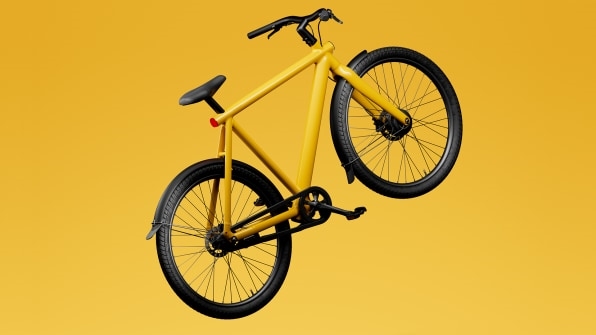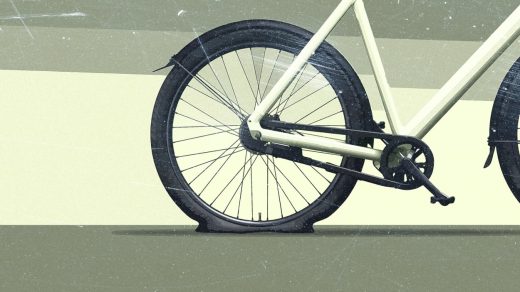VanMoof was a darling of the e-bike industry—then it crashed. Here’s why
By Tim Brinkhof
“An outdated market.” That’s how brothers Taco and Ties Carlier described the bicycle industry back in 2017, a year after they launched their first e-bike. Fast-forward to 2021, and their company, VanMoof, was being hailed as the “Tesla of bike manufacturers.” Its designer models, with customizable alarms and a mobile app instead of a physical key, were selling across the globe, from Tokyo to New York. On the canal-encircled streets of Amsterdam, where the brand emerged, VanMoof bikes were more than vehicles: They were a cultural phenomenon.
Fast-forward again, this time to July 2023, and the Tesla of e-bikes was filing for bankruptcy. The company, whose sales couldn’t keep up with growing losses, ground to a sudden halt last week when a much-needed injection of venture capital failed to materialize. (The company had received more than $175 million in funding over the course of its existence.)
Chaos ensued, especially in the Netherlands. New orders were canceled, existing ones placed in limbo. VanMoof’s flagship stores and repair stations in the Dutch cities of Amsterdam, Rotterdam, and Utrecht closed down, leaving thousands of customers unable to fix their bikes (obtained for a hefty purchase price that ranged from $2,000 to $4,000).
But customers aren’t the only ones affected by VanMoof’s collapse. Other players in the global e-bike market—worth an estimated $18.86 billion in 2022—are trying to understand how their once-promising competitor managed to crash so spectacularly, and how they can avoid making the same mistakes. While the end of VanMoof won’t mean the end of the entire e-bike industry (on the contrary, it’s set to balloon to $119.72 billion by 2030), its demise does offer valuable lessons for those who are still in the race.

VanMoof’s greatest asset—its unique design—was also its biggest weakness. Where most bicycle manufacturers acquire their electric and nonelectric components through established supply chains, the Carlier brothers wanted to create bikes from scratch. Everything, from the sturdy frames to the tiniest gears, was designed by the company. This direct-to-consumer approach helped VanMoof distinguish itself from its rivals (it sold more than 120,000 bikes total, according to its website), but it also generated a host of technical, logistical, and financial challenges.
“As a rule, you should be able to take a bicycle to any shop and have it repaired,” says Jacques Lovell, manager at the trade association Cycling Industries Europe. This was not the case for VanMoof, whose custom-made parts, which require custom-made tools to take apart, were a complete unknown for neighborhood mechanics.
VanMoof had always struggled to keep up with repairs in-house. However, the latest models—which suffered from an unexpectedly large number of bugs, including malfunctioning batteries and stuck shifters—proved too much for the company to handle.
The broader e-bike world is reading VanMoof’s demise as a cautionary tale about the need to strike a balance between innovation and collaboration, idiosyncrasy and conformity. “Innovate as much as you want, but stick to industry standards and make sure mechanics know how to service you,” says Bastian Dietz, an advisory board member of Cycling Innovation Accelerator, which supports startups looking to break new ground. That way, he notes, manufacturers won’t collapse under the weight of their own maintenance requests.
This advice won’t be of much use to a global powerhouse like Pon, which can integrate its various e-bike brands into its $2.5 billion retail and service network. But it could be for smaller companies that had previously followed in VanMoof’s tracks. Think of Cowboy, a Brussels-based firm with a similar design philosophy that raised its prices in response to VanMoof’s bankruptcy. Or hardware manufacturer Acer, which, despite being known for laptops and projectors, is preparing to release a custom-made, AI-driven smart bike for urban commuters called ebii.
While the fate of these e-bikes has yet to be decided, that of VanMoof seems set in stone, with curators seeing which parts of the company might be salvaged. As the Carliers were unable to procure investment when the company was still standing, it’s unlikely they will now that it has fallen over.
Meanwhile, Dietz, who has been covering these developments on LinkedIn, says his posts have caught the attention of employees at Tesla. Could it be that the EV giant is interested in helping its kindred spirit? Probably not, he concedes: “Elon Musk had a bad motorcycle accident when he was young and said he won’t build them, so I doubt he will ever get into e-bikes.”
(25)



